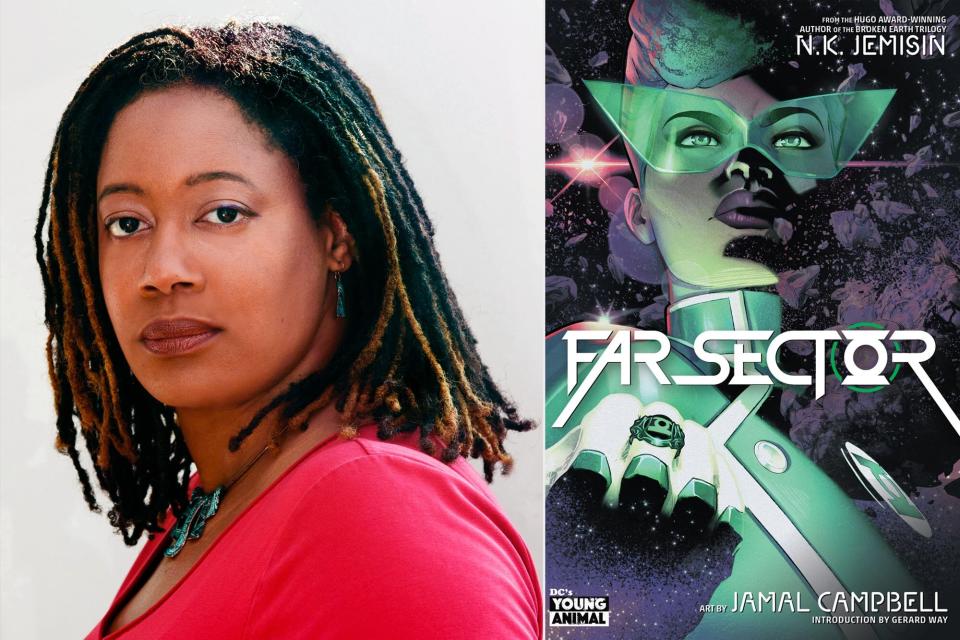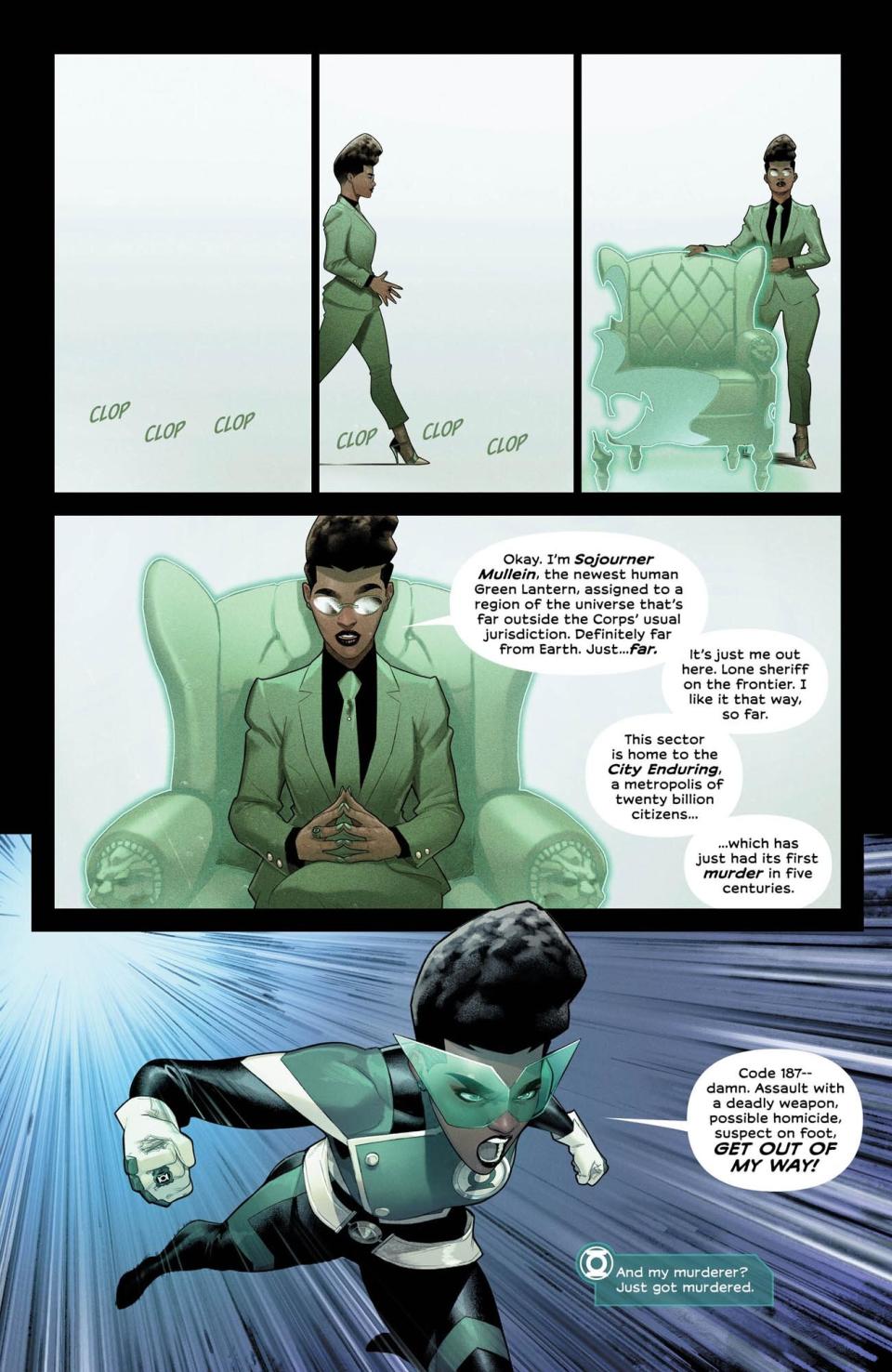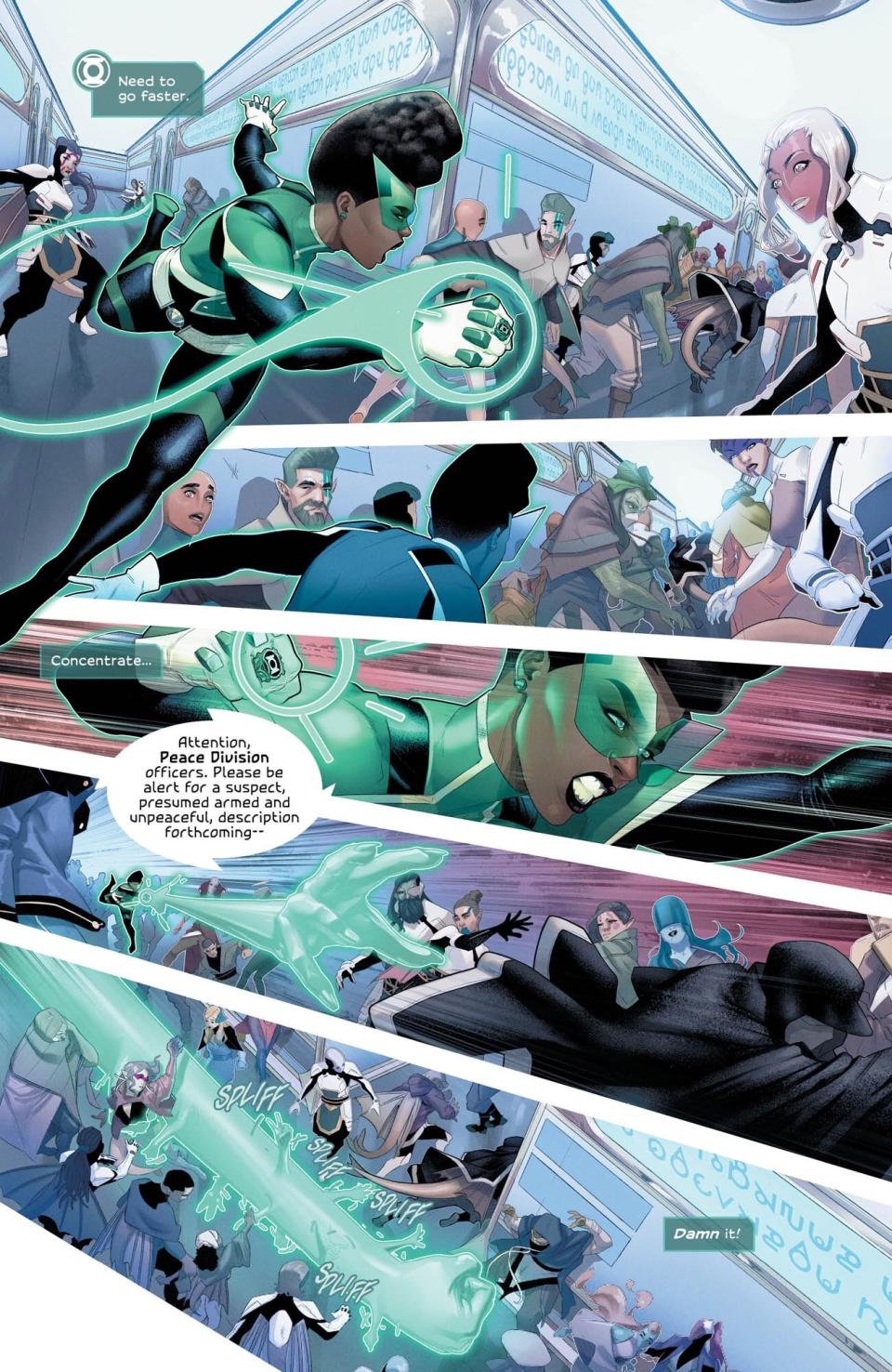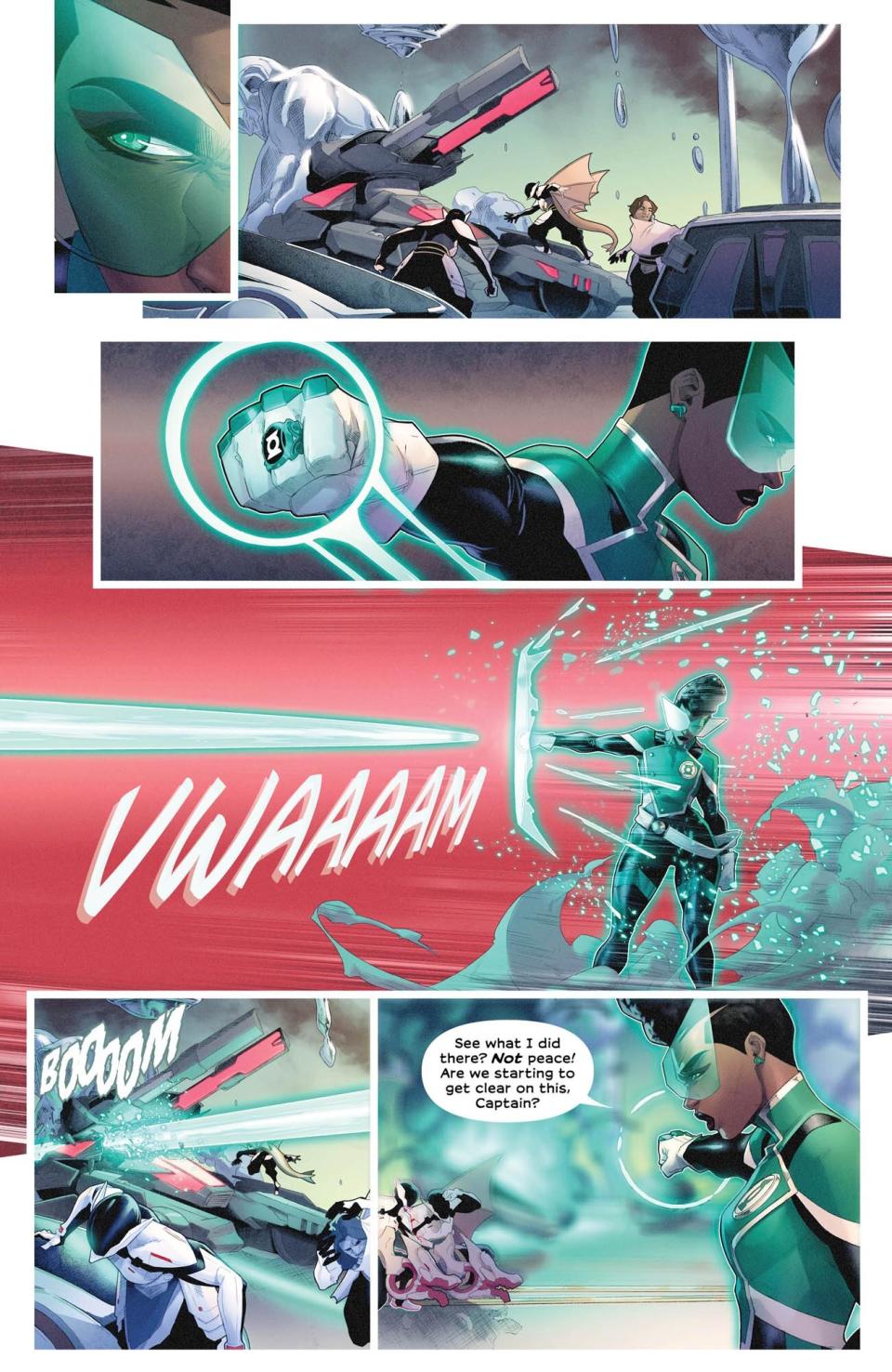How N.K. Jemisin's Green Lantern comic taught her to think visually
Comic books are a beautiful artistic form in and of themselves, but it's always a pleasant surprise to see an artist from a different medium come in and make their mark in the graphic novel format. Such was the case with Far Sector, which saw N.K. Jemisin (the author of EW's favorite fantasy series of the 2010s, and the only novelist to win the top Hugo Award three years in a row) team up with artist Jamal Campbell for a new kind of Green Lantern comic.
Far Sector is set in the world of DC Comics but also apart from it. The protagonist, Sojourner "Jo" Mullein, is a Green Lantern dispatched to the outer-space civilization known as the City Enduring, a Dyson sphere populated by three distinct alien races who live in harmony by banning emotions. But shortly after Jo arrives, this peaceful society gets riven by unheard-of murders and a burgeoning revolutionary movement from citizens who'd actually like to feel something.
Consisting of 12 issues, Far Sector launched in November 2019 and finally wrapped up earlier this year, after suffering through the COVID-19 delays that especially affected the comics industry last year. Now a collected edition is available featuring all of Far Sector in one handy volume, which should make it more accessible for Jemisin fans who are used to picking her work up from the bookstore, not checking comic sales every month. EW caught up with Jemisin to discuss Far Sector and how it taught her to think about stories in a new way.

Laura Hanifin; Jamal Campbell for DC Comics Author N.K. Jemisin made her comic book debut with the sci-fi superhero story 'Far Sector'
ENTERTAINMENT WEEKLY: With the City Enduring, you were able to create your own world within the greater canvas of the DC universe. The concept of Green Lanterns exists here, but it's so far out from everything else that you weren't in danger of Martian Manhunter or whoever popping in, and you were able to create your own new alien species. What was fun about staking out a little bit of territory for yourself?
N.K. JEMISIN: I love world building, obviously, since we just talked about that. It was a chance for me to play with some things that I haven't really had the chance to dig into before and to create some characters that I thought were memorable and interesting, and who I would like to revisit and play with again at some point.
I had always designed Jo to be transferable into the great Green Lantern canon. That was one of the reasons why I wanted her to come out in floppy form first, because I understand the comic book audience enough to understand that when something comes out in graphic novel only, there's a certain subset of the comic audience that's just going to dismiss that — like she's not a real Green Lantern unless she's in a monthly series. So that was the goal, to set her up for whatever future usage within or without the canon. I feel like I accomplished that, because it worked.
I love to see her pop up in other things. I was wondering if you were excited about that or if you still felt a little protective of her?
No, no. When I decided to do a comic book, I knew what I was getting into. I've been a comic book fan for like most of my life, but I understood going into it that she would not be mine to happen to hold forever. This was a thing that I was throwing into the wind and seeing where the seeds would sprout. She's landed pretty well, as far as I'm concerned.

Jamal Campbell for DC Comics Jo Mullein tries to make her way as a Green Lantern in 'Far Sector,' by N.K. Jemisin and Jamal Campbell
As a longtime comic fan, I assume maybe you've had thoughts or daydreams before in the past about what you would do with a comic or what kind of comic you would like to write. What was the biggest surprise of actually doing it and transitioning from novels and short stories other to this different format?
This is going to sound a little weird, but I never thought of myself as a visual person before. It's difficult to describe, but when I write my novels, I don't see images in my head. I see impressions of things, if anything. I guess my mind is always steered away from specifically imagining faces or things like that. I want the basics in place, but I want the reader to have their own mind's eye fill in the fine details. But as I was working on Far Sector, I discovered, "Wait, I'm a lot more visual than I thought."
It's a good thing because now I'm working on a film script. Sony purchased the rights to adapt the Broken Earth trilogy as films. I'm writing the scripts for those, or at least for now I am; we'll see how they like my scripts. That is a wholly visual medium. So working on the comic book script helped me make that transition in a way that I think would've been a lot harder otherwise, because I just never thought of myself as visual before. My mind just doesn't work like that, but now it does because of comic books.
How has that changed your approach to the Broken Earth material? Are you going back and trying to see it in a different, more visual way?
It's difficult to describe, but for example, a lot of my characters' growth and development occurs in internal ways. They will have epiphanies, they will have a moment of revelation where they suddenly understand a thing. That can be a dramatic moment in a book because that moment of understanding is a beat in the character arc. You can get inside their head and you can make that dramatic or powerful or important. You can't do that in a film. You can't do it in a comic book. Because we can't see inside their head. You have to make that moment of revelation visual and physical. And they can talk through some of the revelation, but at the end of the day, there has to be a physical, visual thing that happens that changes this person. So now I have to come up with events instead of epiphanies.
Since we're talking about the visual nature of comics, I wanted to ask you about your collaboration with Jamal Campbell, because he just blew me away with every issue. One of the reasons I'm so excited about the collected edition is so that I can just pull it off the shelf and flip through the art at any time. Did he help you wrap your head around this visual medium?
He did, and I'm most impressed by the fact that he did it without saying a word. I've only met him by phone because of course COVID kind of stopped a lot of physical meeting opportunities, but we worked together primarily by via email.
So in my early scripts for Far Sector, I'm describing things a lot more because I just really had no idea how to work with an artist. Then I would cut that down and worry that I hadn't included enough information, and Jamal would just do it. He would just take my overwritten, overly elaborate things and create something that was just so stunning that I was like, "I didn't need to say 90 percent of that." So my later scripts are much shorter because I'm just like, "I know your work. I know that you can magically intuit what I'm trying to get across here. So I will give you the extremely bare sketch of it, and [you can] go whole hog." And he would, he would just do that thing so amazingly. So what I learned was when you're working with a person who is a true master of their craft, which Jamal Campbell definitely is, don't get in their way. Don't overdo it. Just step back and let them work. And he did it.

Jamal Campbell for DC Comics Jo Mullein tries to catch a suspect in 'Far Sector,' by N.K. Jemisin and Jamal Campbell
Comics are obviously a visual medium, and Green Lanterns in particular are perhaps the most visual superheroes because of the nature of their power and the hard-light constructs they wield. To take that as an example, would you describe exactly what the constructs should be? Or would you just say, "She's doing something like this," and let Jamal riff on it?
It varied. But in most cases I would say specifically what the construct was supposed to be and what I intended to come across. There's an early scene where Jo is chasing a suspect through the futuristic police station. And I just said, "She reaches with a construct, a giant hand through the crowd, weaving among the crowd, trying to not hurt anybody, but try trying to grab this person." And visually that didn't work; visually weaving would've made the arm that the hand was attached to this weird noodle thing. And I realized belatedly that it would look ridiculous, but Jamal just drew it as like a giant fist and it was perfect. So a giant reaching hand, and it was not what I had described, but it was exactly what that scene needed. So what I learned to do was just put in my intention and a sort of general gist and then to trust him, and he met that trust.
Of all superheroes, Green Lanterns are perhaps the most forthright at being cops. They're basically superhero space cops. You really tackle that head-on in terms of Jo's past. She's wrestling with her past experience as a cop on Earth and contrasting it with her work in the City Enduring over the course of the story. What did you want to explore there? Especially since Far Sector just happened to be coming out at a time when we were having lots of conversations in the real world about policing.
Well, I started writing Far Sector like two years before the summer where all of that stuff was happening. Granted, I live in America, so this is going to happen frequently. I was writing the Broken Earth books during Ferguson. So it's not really predictive or anything like that. It's just, I knew we were still going to be dealing with the same old s‑‑‑.
What I wanted to do with it was do an empathetic portrayal of a Black cop who is affected by all of that. But I specify empathy, not sympathy; you don't feel sorry for her. I don't want you to excuse the fact that her inaction caused a man to be hospitalized, to lose his job, that his family could end up homeless. She laments her own errors and the wrong that she did there, but I want people to understand. And I wanted to do a realistic portrayal of a person who genuinely wanted to do good, who went into the cops and discovered that there's systemic badness in the way that cops operate in this country, and who basically chose the only option that a good cop has, which is to stop being a cop.

Jamal Campbell for DC Comics Jo Mullein wields power in 'Far Sector,' by N.K. Jemisin and Jamal Campbell
The collected edition of Far Sector is available now wherever comics are sold.
Related content:

